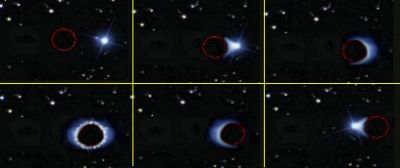Wormhole — Between Alchibah and Earth
Observations by William Bartlett
Composite photo of original images SSI-1154132-7

The Discovery
In the early 2040’s the UNWG funded a project to look for nearby Wormholes or other massive near system objects. They were to be found using a method called gravitational micro lensing, the bending of light caused by the gravity of an object passing in front of, or very near to, the sight line to a more distant light source. By the late 20th century several extra-solar planets had already been discovered using this method. If the distance to the light source were known accurately enough several measurements could give an estimation of the intervening objects mass, size and distance.
Earth based instruments, by taking photos on opposite sides of the planet’s orbit, had given accurate stellar distances out to about 400 Light Years. There just weren’t enough stars that close to Earth to expect an object as small as an outer system Wormhole to be seen near enough to one of these stars for the bending to be noticed or the measurements made. The UNWG proposed to build an observatory on Saturn so as to have a longer base line. They expected good numbers out to perhaps 5000 Light Years. The project was to take about 30 years as Saturn went around in its orbit.
R. J. Hamilton heard about the program and had an idea for an improvement. Instead of one observatory he built 25 spacing them roughly 15 deg. apart just outside of Saturn‘s orbit, and thus was able to accomplish in a little over a year what would take the UNWG 30. The Orbiting Observatories were similar to the familiar Earth based Space Telescope, and were in an orbit around the sun with a slightly larger diameter than Saturn’s thus Hamilton would have an even longer base line to measure distances from.
He could have used 5 platforms spaced equally and still beat the UNWG but it would have taken longer. He had the resources for more and was in a hurry.
With so many cameras he had many more photographs for his comps to examine, hence more accurate measurements of distance, mass, and indications of light being lensed or bent. Even with all the photos he took it was an unlikely statistical occurrence to capture an object as small as the Alchibah Wormhole passing very near the sightline of a nearby star in so short a time.
An additional benefit of Hamilton’s procedure was that his accuracy let him rule out investigating quite a number of previously undiscovered objects in the outer solar system that though large in size were not massive enough to be Wormholes. By 2042 Hamilton was ready to launch his first exploratory ship.
There is a certain amount of confusion concerning the popular myth that Brandon Carter had just stumbled across the Wormhole. It appears much more likely that Hamilton had sent him out to investigate at the proper spot and was happy enough to let Carter get the credit. See Historian’s interview with R. Williams/L. Monroe/et al.
Posted in W |